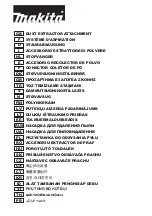
FG10239-1-0214
Page 9
INSTALLATION
Figure 8
INSTALLING THE APPLIANCE INTO A FIREPLACE
1. Place the Fiamma Burner Pan into the fireplace (unit is pack
-
aged as a match-throw, dual burner assembly; valve,pilot and
gas train must be assembled). The unit should be centered
from both side to side and front to back in the fireplace. The
unit is shipped ready for rear gas connection only. See Figure
2.
2. Bend a 3/8” gas line with two 3/8” brass, female flare fittings
(included on some models) to facilitate the gas connection
between the burner and the gas stub.
CAUTION:
Gas lines are easily kinked if bent too sharply.
3. Using an adjustable wrench, and turning in a clockwise
direction, attach a 1/2” female flare x 3/8” male flare brass
reducer fitting (included on some models) to the gas stub.
4. Using two adjustable wrenches, and turning in a clockwise
directions, attach one end of the gas line to the brass re-
ducer fitting installed in the previous step (one wrench on the
brass gas line fitting, and one wrench on the brass reducer
fitting).
5. Using two adjustable wrenches, and turning in a clockwise
direction, attach the other end of the gas line to the brass
fitting on the burner (one wrench on the gas line fitting, and
one wrench on the brass fitting on the burner).
CAUTION:
Make sure all gas connections are snug but DO
NOT over tighten!
STOP! IT IS OUR RECOMMENDATION TO LIGHT THE PILOT
AND TEST THE IGNITION BEFORE ATTEMPTING TO SET
UP THE LOGS.
FOR UNITS WITH GAS CONTROL VALVES:
SEE “UNITS
WITH REMOTE SYSTEMS” SECTION ON PAGE 9 AND
“LIGHTING INSTRUCTIONS WITH SAFETY PILOT ON PAGE
14 BEFORE CONTINUING ON WITH THE INSTRUCTIONS
FOR MATCH THROW UNITS:
THIS IS NOT NECESSARY.
ONCE YOU HAVE COMPLETED THE STEPS IN THIS SEC-
TION, CONTINUE ON TO “FINAL SET UP” ON PAGE 12.
6.
CHECK FOR LEAKS!
Apply soapy water to each connection
and watch for bubbles. If bubbles are seen, turn off the gas
supply, retighten the connections and
CHECK AGAIN. DO
NOT
use a lighted match or other source of ignition to check
for leaks. Repeat this procedure until you are sure that there
are no leaks. Proceed to “FINAL SET UP on page 12.
WARNING
DO NOT use sand in Liquid Propane Hearth Kits. Use the
Vermiculite, provided with the Liquid Propane Change Kit.
FOR UNITS WITH REMOTE SYSTEMS
All burner systems are capable of operating with a latching sole-
noid remote control system. See the instructions packaged with
the remote system that you have purchased for detailed installa-
tion and operational characteristics. The following instructions are
a general guide for installation only.
Label all wires prior to disconnection when servicing controls.
Wiring errors can cause improper and dangerous operation.
Verify proper operation after servicing.
These Vented Burner Systems use:
The American Flame AF-1000 Series Valve (AF-1010 shown here
with remote solenoid shown separately in diagram). All systems
use a safety pilot with a thermocouple. See Figures 4-5 & 8.
CONNECTING THE RECEIVER TO THE VALVE
Notice: For extended, remote applications, extension wire (not
provided) will be necessary for your distance run.
1. The wire harness should already be installed to the terminal
bock on the rear of the remote receiver.
FOR HANDHELD TRANSMITTER REMOTE RECEIVERS, SEE
FIGURES 11 - 13.
FOR WALL SWITCH TRANSMITTER REMOTE RECEIVERS,
SEE FIGURES 14 - 16.
WIRING SCHEMES FOR THE TERMINAL BLOCKS AND OP-
ERATIONS CHARACTERISTICS VARY BETWEEN THE TWO
SYSTEMS.
2. Connect the BLACK 18 gauge wire with the 1/4” female ter-
minal from the receiver to the BLACK wire with the 1/4” male
terminal from the valve solenoid.
3. Connect the RED 18 gauge wire with the 1/4” female ter-
minal from the receiver to the RED wire with the 1/4” male
terminal from the valve solenoid.
4. After receiver wires are connected to the valve solenoid
wires, make sure the receiver shield is located over the
receiver and then locate the receiver in an area that will not
exceed 130°F (preferably outside the firebox, on the fire
-
place hearth).
IMPORTANT
Operation of these controls is dependent upon which wire is
attached to which terminal. If operation does not correspond to
operating buttons on the transmitter, reverse the wire installa-
tion at the receiver or at the transmitter. See Figures 12, 13, 15,
& 16.
Notice: Up to 6.3 VDC of power is provided at the receiver termi-
nal.










































